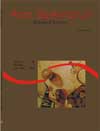<b>Flora bacteriana de tilápia do Nilo, <em>Oreochromis niloticus</em>, cultivada em sistema semi-intensivo</b> - DOI: 10.4025/actascibiolsci.v25i2.2007
Resumo
A flora bacteriana de diferentes partes do trato gastrintestinal de tilápia Oreochomis niloticus L. (Cichlidae) foi determinada. O número médio de bactérias foi maior no intestino anterior e posterior quando comparado ao estômago. A porcentagem total de espécies bacterianas isoladas e a porcentagem de espécies isoladas em uma espécie particular variaram significativamente entre as regiões do trato gastrintestinal. Aeromonas hydrophila, Aeromonas veronii, Burkholderia cepacia, Chromobacterium violaceum, Citrobacter freundii, Escherichia coli, Flavimonas oryzihabitans e Plesiomonas shigelloides foram os bacilos Gram-negativos encontrados com maior freqüência. Destas espécies, somente Plesiomonas shigelloides esteve presente em cada região do trato gastrintestinal, apresentando maior número no intestino posterior (76%), quando comparado com o intestino anterior (4.8%) e o estômago (0.6%). Aeromonas hydrophila (0.6%), Escherichia coli (7.4%), e Flavimonas oryzihabitans foram isoladas somente do estômago, e Citrobacter freundii e Burkholderia cepacia foram encontradas somente no intestino posterior. Chromobacterium violaceum foi a espécie dominante isolada do estômago e do intestino anterior com 90% e 55%, respectivamente. Organismos não identificados compreendem 0 – 39.3% da microbiota gastrintestinalDownloads
DECLARAÇÃO DE ORIGINALIDADE E DIREITOS AUTORAIS
Declaro que o presente artigo é original, não tendo sido submetido à publicação em qualquer outro periódico nacional ou internacional, quer seja em parte ou em sua totalidade.
Os direitos autorais pertencem exclusivamente aos autores. Os direitos de licenciamento utilizados pelo periódico é a licença Creative Commons Attribution 4.0 (CC BY 4.0): são permitidos o compartilhamento (cópia e distribuição do material em qualqer meio ou formato) e adaptação (remix, transformação e criação de material a partir do conteúdo assim licenciado para quaisquer fins, inclusive comerciais.
Recomenda-se a leitura desse link para maiores informações sobre o tema: fornecimento de créditos e referências de forma correta, entre outros detalhes cruciais para uso adequado do material licenciado.












1.png)




3.png)













